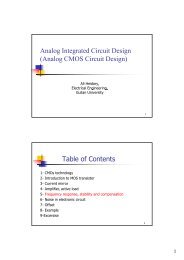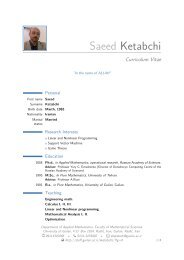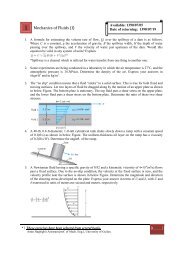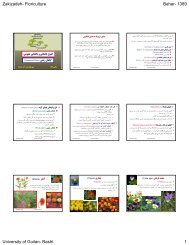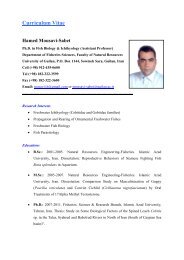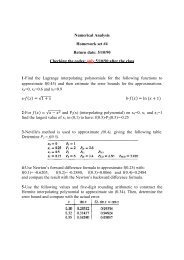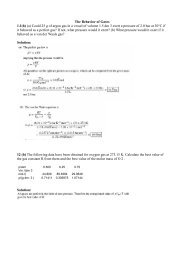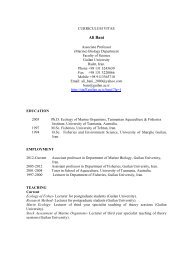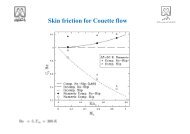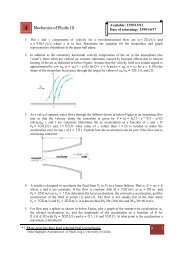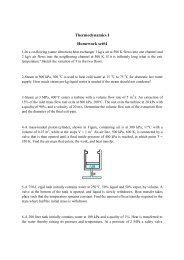3 Mechanics of Fluids (I)
3 Mechanics of Fluids (I)
3 Mechanics of Fluids (I)
Create successful ePaper yourself
Turn your PDF publications into a flip-book with our unique Google optimized e-Paper software.
3 <strong>Mechanics</strong> <strong>of</strong> <strong>Fluids</strong> (I)Available: 1390/09/14Date <strong>of</strong> returning: 1390/09/231. Water flows steadily through the variable area vertical pipe shown in below Figure. Centerlinevelocity is given by where x is in feet. Viscous effects are neglected. (a) Determine the pressuregradient, 1as a function <strong>of</strong> x2 needed to produce this flow. (b) If the pressure at section 112 is 50psi, determine the pressure at 122 by 1i2 integration <strong>of</strong> the pressure gradient obtained in (a), 1ii2application <strong>of</strong> the Bernoulli equation.2. An incompressible fluid with density ρ flows steadily past the object shown in below Figure. Fluidvelocity along the horizontal dividing streamline -∞≤x≤-a, is found to be V=V (1 + ) where a, isthe radius <strong>of</strong> curvature <strong>of</strong> the front <strong>of</strong> the object and is the upstream velocity. (a) Determine thepressure gradient along this streamline. (b) If the upstream pressure is p , integrate the pressuregradient to obtain the pressure p(x) for -∞≤x≤-a (c) Show from the result <strong>of</strong> part (b) that thepressure at the stagnation point is (x=-a) is p + ρV /2 as expected from the Bernoulli equation.3. Water flows around the vertical two-dimensional bend with circular streamlines and constantvelocity as shown in below Figure. If the pressure is 40kPa at point (1), determine the pressures atpoints (2) and (3). Assume that the velocity pr<strong>of</strong>ile is uniform as indicated.* | These exercises have been selected from several books.Amin Haghighi (Asistant pr<strong>of</strong>. <strong>of</strong> Mech. Eng.), University <strong>of</strong> Guilan.1
3 <strong>Mechanics</strong> <strong>of</strong> <strong>Fluids</strong> (I)Available: 1390/09/14Date <strong>of</strong> returning: 1390/09/234. Water flows from a pop bottle that has holes in it as shown in below Figure. Two streams comingfrom holes located distances h , h and below the free surface intersect at a distance L from theside <strong>of</strong> the bottle. If viscous effects are negligible and the flow is quasi-steady, show thatL = 2(h h ) . Compare this result with experimental data measured from the paused video forwhich the holes are 2 inches apart.5. A 40-mph wind blowing past your house speeds up as it flows up and over the ro<strong>of</strong>. If elevationeffects are negligible, determine (a) the pressure at the point on the ro<strong>of</strong> where the speed is 60mphif the pressure in the free stream blowing toward your house is 14.7psia. Would this effect tend topush the ro<strong>of</strong> down against the house, or would it tend to lift the ro<strong>of</strong>? (b) Determine the pressureon a window facing the wind if the window is assumed to be a stagnation point.6. Streams <strong>of</strong> water from two tanks impinge upon each other as shown in below Figure. If viscouseffects are negligible and point A is a stagnation point, determine the height h.7. Water is siphoned from the tank shown in below Figure. Determine the flow rate from the tank andthe pressures at points (1), (2), and (3) if viscous effects are negligible.8. A spherical tank <strong>of</strong> diameter D has a drain hole <strong>of</strong> diameter d at its bottom. A vent at the top <strong>of</strong> thetank maintains atmospheric pressure at the liquid surface within the tank. The flow is quasi-steadyand inviscid and the tank is full <strong>of</strong> water initially. Determine the water depth as a function <strong>of</strong> time.* | These exercises have been selected from several books.Amin Haghighi (Asistant pr<strong>of</strong>. <strong>of</strong> Mech. Eng.), University <strong>of</strong> Guilan.2
3 <strong>Mechanics</strong> <strong>of</strong> <strong>Fluids</strong> (I)Available: 1390/09/14Date <strong>of</strong> returning: 1390/09/239. The surface area, A, <strong>of</strong> the pond shown in below Figure varies with the water depth, h, as shown inthe table. At time t = 0, a valve is opened and the pond is allowed to drain through a pipe <strong>of</strong>diameter D. If viscous effects are negligible and quasi-steady conditions are assumed, find thewater depth as a function <strong>of</strong> time from when the valve is opened(t = 0) until the pond is drainedfor pipe diameters <strong>of</strong> and 3.0 ft. Assume h = 18ft, at t = 0.10. Water flows from the pipe shown in below Figure as a free jet and strikes a circular flat plate. Theflow geometry shown is axisymmetrical. Determine the flow rate and the manometer reading, H.11. Water is flowing through two holes from a container with frictionless wheels. The left hole islocated at a height <strong>of</strong> h 1 =0.3m and its area is 3cm 2 , and the right hole area is 1cm 2 . If the waterlevel in the container is h 2 =0.7m, calculate the resultant force and its direction on the container.12. The container shown in the figure is filled with water. The water discharges through a hole <strong>of</strong> areaA 2 at the lower right. (a) Develop an expression for the discharge velocity u 2 . (b) Calculate the rateat which the water level drops at point 1?* | These exercises have been selected from several books.Amin Haghighi (Asistant pr<strong>of</strong>. <strong>of</strong> Mech. Eng.), University <strong>of</strong> Guilan.3
3 <strong>Mechanics</strong> <strong>of</strong> <strong>Fluids</strong> (I)Available: 1390/09/14Date <strong>of</strong> returning: 1390/09/2313. The neighbor kid decided to water the garden while standing on his skateboard. As he opened thevalve, the circular jet speed was 7m/s and its diameter was d 2 =0.02m. If his total mass is 40kg, thencalculate the force <strong>of</strong> the jet and his initial acceleration (assuming no friction).14. A handheld bicycle pump can be used as an atomizer to generate a fine mist <strong>of</strong> paint or pesticide byforcing air at a high velocity through a small hole and placing a short tube between the liquidreservoir and the high-speed air jet whose low pressure drives the liquid up through the tube. Insuch an atomizer, the hole diameter is 0.3cm, the vertical distance between the liquid level in thetube and the hole is 10cm, and the bore (diameter) and the stroke <strong>of</strong> the air pump are 5cm and20cm, respectively. If the atmospheric conditions are 20°C and 95kPa, determine the minimumspeed that the piston must be moved in the cylinder during pumping to initiate the atomizing effect.The liquid reservoir is open to the atmosphere.15. Water enters a tank <strong>of</strong> diameter D T steadily at a mass flow rate <strong>of</strong> ṁ in. An orifice at the bottomwith diameter D o allows water to escape. The orifice has a rounded entrance, so the frictional lossesare negligible. If the tank is initially empty, (a) determine the maximum height that the water willreach in the tank and (b) obtain a relation for water height z as a function <strong>of</strong> time.* | These exercises have been selected from several books.Amin Haghighi (Asistant pr<strong>of</strong>. <strong>of</strong> Mech. Eng.), University <strong>of</strong> Guilan.4




